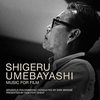Soundtrack Information
Music From
Music By
Purchase Soundtrack
Track Listing
| 1. | Opening Title | 0:58 |
| 2. | "Beauty Song (Jia Ren Qu)" - Zhang Ziyi | 2:32 |
| 3. | The Echo Game | 1:17 |
| 4. | The Peonyhouse | 1:22 |
| 5. | Battle in the Forest | 3:26 |
| 6. | Taking Her Hand | 1:14 |
| 7. | Leo's Eyes | 1:51 |
| 8. | Lovers (Flower Garden) | 2:19 |
| 9. | No Way Out | 3:59 |
| 10. | Lovers | 1:54 |
| 11. | Farewell No. 1 | 2:42 |
| 12. | Bamboo Forest | 2:36 |
| 13. | Ambush in Ten Directions (Shi Mian Mai Fu) | 2:01 |
| 14. | Leo's Theme | 2:36 |
| 15. | Mei and Leo | 3:06 |
| 16. | The House of Flying Daggers | 1:27 |
| 17. | Lovers (Mei and Jin) | 4:21 |
| 18. | Farewell No. 2 | 2:49 |
| 19. | Until the End | 2:55 |
| 20. | "Lovers (Title Song)" - Kathleen Battle | 4:12 |
| Total Album Time: | 49:37 |
Related Albums

Shigeru Umebayashi - Music for FilmSilva Screen
Released: November 26, 2021
Formats: CD, Digital (73 min)
Music Used in Trailers
 Theatrical Trailer
Theatrical Trailer- Curse of the Golden Flower (2006) - Shigeru Umebayashi
 Teaser Trailer
Teaser Trailer- Memoirs of a Geisha (2005) - Shigeru Umebayashi
Review: House of Flying Daggers
3.5 / 5 Stars
This past summer, after languishing on Miramax's shelves for several years, Zhang Yimou's martial arts epic Hero was finally released in the United States. Critics raved, audiences cheered, and the film did so well at the box office, that Zhang's follow-up effort, House of Flying Daggers, was slated for quick release.
Since the two films share the same director, a similar sumptuous visual style, and a genre, as both are historical martial arts epics, there have inevitably been numerous comparisons between them. Tan Dan, who won an Oscar for his Crouching Tiger, Hidden Dragon score, wrote the music for Hero. His score was lush, thematic, and drew equally from the Chinese and Western musical traditions. Shigeru Umebayashi, best known in America as the leader of Japan's new-wave rock band EX, wisely chose to take a different approach, one that helps differentiate House of Flying Daggers from Hero in several subtle ways.
Umebayashi is Japanese, and it seems as though his heritage played a deciding factor in his music for the film. Umebayashi's score is more like the work of his countryman Toru Takemitsu, who contributed such a powerfully effective and poetic score for Kurosawa's Ran back in the 1980s, than anything Tan Dun has done for film. Although House of Flying Daggers uses many, many traditional Chinese instruments, from the erhu to the pipa to the dizi, Umebayashi places them in the soundscape, rather than allowing them to combine and overwhelm the scene. Let me explain what I mean by "placing." Most cues use one or two instruments at most, and each note has a precise place in the cue, creating perfect balance among the sounds. In fact, there are many moments where Umebayashi even allows an instrument's sound to slowly decay, hanging into pure silence as though at the edge of a precipice. Just listen to the sparseness of the bamboo flute in "The House of Flying Daggers." There is a tension and an openness to the cue that lends it power. Using silence in this manner is an extremely effective technique in traditional composition and lends a lyrical stillness to the new film that Hero lacked. It is this subtle use of silence, something few Western or Chinese composers would think of trying, that makes House of Flying Daggers so compelling.
This is not to say that the score is better than Hero; as a stand alone experience I actually find it a little less compelling than the earlier score. The main reason for this feeling comes from the strange mix of Chinese cues and those that seem more inspired by ethno-pop music. There are several cues, such as "The Peonyhouse," that combine the Chiense elements with a synthesized beat and even sampled voices. The end result is a cue that seems out of place in the overall tone of the score and film, especially considering that such cues are usually quickly followed by ones like "Battle in the Forest," which opens with the Zen rock garden approach of putting sounds into silence before returning to the marriage of synths and traditional instruments.
Still, House of Flying Daggers is a remarkably beautiful and poetic score, one which, in many ways, is the antithesis of what most lovers of film scores have in their collections. For that reason alone, I'm afraid that it is likely to be overlooked. But if you are willing to stretch outside your normal comfort zone, you'll find a compelling score that uses traditional scoring techniques such as recurring motives and atmospheric textures in untraditional ways to create one of the year's more memorable scores.
-
Click stars
to rate.
If any information appears to be missing from this page, contact us and let us know!
